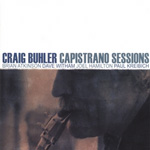Home » Jazz Articles » Book Review » Duane Allman & Eric Clapton: The Triumph And Tragedy Of ...
Duane Allman & Eric Clapton: The Triumph And Tragedy Of Two Guitar Heroes
These two books suggest fate decreed Eric Clapton and Duane Allman collaborate on the masterwork that is Layla.
 |  | Skydog: The Duane Allman Story Randy Poe Hardcover; 320 pages ISBN: 0879308915 Backbeat 2006 | Layla And Other Assorted Love Songs By Derek And The Dominos Jan Reid Hardcover; 160 pages ISBN: 1594863695 Rodale 2006 |
Great guitarists are no less a fascination to each other than to the music loving, guitar-hero worshipper, perhaps more so. Why else would Jim Hall and Pat Metheny, Rory Gallagher and Muddy Waters, and last but not least, Eric Clapton and Duane Allman play together? Two recent books detailing the triumph and tragedy of the latter two make it seem as if fate decreed Clapton and Allman would collaborate on the masterwork that is Layla.
Much has been written on the genesis of Layla And Other Assorted Love Songs, Clapton's most famous piece of work. At least some of the writing depicts the means by which Allman jump started the sessions for this pivotal album when he entered but a short way into them (see Gene Santoro's liner notes to the 20th Anniversary Edition). The revelation, if you want to call it that, of Jan Reid's book is that there isn't much more to say about the album than the music itself states so eloquently and passionately.
Say this for Reid though, he does an admirable job as an academic researcher. Delving ever so thoroughly, perhaps more than anyone before him, into the story behind the Arabic folk legend on which Clapton named the song and album, Reid also explores the background of the great English guitarist himself. That enquiry leads inevitably into a similar outline of the roots of his American counterpart. The subsequent tale of the dissipation of the inspiration that led to the formation of Derek And The Dominos is a familiar story of self-indulgence and personality conflict, but with a crucial difference: the music preceding the downslide is transcendent.
What distracts from all this solid work is the high-strung means by which the author relegates the less-than-lurid aspects of the story to the background. Reid re-emphasizes to a fault the soap-operatic convolutions involving Clapton, his friend Beatle George Harrison and the object of their affections Pattie Boyd—Harrison's wife and Clapton's paramour. These goings-on eventually take as much precedence in this melodrama as the chemistry by which Clapton and Allman created, through their guitar work and the overall musicianship of The Dominos, what is arguably the greatest rock album of all time.
Reid's interviews with Bobby Whitlock are the primary source of insight into this phase of Clapton's career. Having become estranged from Delaney & Bonnie, the keyboardist/songwriter/vocalist (who also contributes insight to the Duane Allman biography, particularly in reference to the Dominos' recording sessions), ends up living with Clapton in England for a period of time. He plays an integral role in the composing process that evolved into the Layla album and helped in the assembly of the Clapton band. His boyish enthusiasm encouraged Clapton in those positive musical activities, yet his nonchalance about the substance abuse surrounding the group is notable as well.
Layla And Other Assorted Love Songs By Derek And The Dominos thus becomes a natural starting place from which to proceed to Randy Poe's book, the first attempt at a comprehensive biography of Duane Allman. Depicting a man of good humor, endless passion for music, and an addictive personality more hooked on the joy of playing than on drugs and alcohol, it makes perfect sense that the Southern guitarist lit the fire under Clapton and the Dominos to sustain the creative spark at the heart of Layla and bring it to fruition in all its agony and ecstasy.
Skydog: The Duane Allman Story is a fast-paced read full of essential detail. It's an unusually suspenseful biography as it documents the evolution and demise of Duane and brother Gregg's Hourglass band, the 31st of February with Butch Trucks, and The 2nd Coming with Dickey Betts and Berry Oakley. In doing so, it makes the grouping of the original line-up of The Allman Brothers Band seem, like so much else in Allman's tale, the work of destiny. ZZ Top guitarist Billy Gibbons' foreword is an unexpectedly touching piece of mini-drama: only obliquely touching upon the precise yet abandoned style of Allman's slide playing—the distinctive likes of which centered him as a musician, solidified his reputation among peers like Gibbons, and ultimately stood as a metaphor for his reckless personality—it effectively sets the scene for the story to follow.
Poe does a good job of putting the most significant issues in their proper historical contexts. There's an implicit commentary on the concert business when he discusses the ABB's work at The Fillmore auditoriums of the late impresario Bill Graham. The author's allusions to Allman's drug and alcohol use, as in the recounting of a New York radio interview, serve to illustrate the intensity of the guitarist's personality, not just use it as fodder for gossip and/or innuendo.
The resulting picture of Allman—his Skydog nickname formalized by Wilson Pickett—is that of a serious musician getting more serious all the time. Just as the iconic Southerner's talent might have begun to fossilize, his discovery of the jazz dynamic, furthered through his introduction (via Capricorn major domo Phil Walden) to former Percy Sledge drummer Jai Johanny Johansson, escalates his drive to a higher level. It leads inexorably, as do many other of his transitions, to the next fateful step of his career, in this case his work with King Curtis and Herbie Mann.
In keeping with his tempered tone, Poe understates Allman's contribution to Layla. Instead of over-dramatizing the encounter with Clapton, Poe lets the sequence of events speak for itself, including how Allman devised the famous opening to the title song on the album. He points out, crucially, how Allman forsook ABB gigs to be sure to complete the recording. It's here that Allman, only 24 years old at the time of his death, sounds like a wise and knowing individual beyond his calendar years.
The artful depiction of this phase of Allman's career makes his tragic death in the motorcycle accident of 1971 seem inevitable as well. As Allman continued to do session work even as the demand for ABB grew and grew, the fatigue factor, combined with increasing drug use throughout the band, resulted in a vicious downward spiral. Duane's brother Gregg is conspicuously absent as this theme unfolds, his presence supplanted by Berry Oakley. Killed in an accident eerily similar to Duane's in 1972, the bassist took Allman's death the hardest of the ABB family, plunging into a morass of alcohol and drugs resembling nothing so much as a death wish.
The author references how Allman himself alluded, somewhat morbidly, to his own early demise in the later months of his own life. It's symbolic of the man's influence on the young Southern culture of the late 1960s and early 1970s that Poe speaks without melodrama of the ABB's post- death activities. Again he allows the facts, such as they are, to speak for themselves as he talks of Gregg Allman's marriage to Cher and the sale of the Muscle Shoals recording studios where Duane first made a reputation for himself. Throughout Skydog: The Duane Allman Story, a selection of photos both illustrates the unfolding story and piques the reader's curiosity, ultimately making the book worthy of close perusal.
It's a tribute to Poe and his subject that the later chapters don't come across as rushed or superficial, as is the case with all too many contemporary biographies. Given that, it's odd that current Allman Brothers members such as Derek Trucks and Oteil Burbridge aren't allowed to provide some perspective on the legacy of Duane Allman. Perhaps that's for a revised edition some years in the future—or even another book altogether, one capturing the recurring rites of passage navigated by ABB, all of which was set in motion by the indomitable (if slightly flawed) free-spirit of its figurehead Duane Allman.
Tags
PREVIOUS / NEXT
Support All About Jazz
 All About Jazz has been a pillar of jazz since 1995, championing it as an art form and, more importantly, supporting the musicians who make it. Our enduring commitment has made "AAJ" one of the most culturally important websites of its kind, read by hundreds of thousands of fans, musicians and industry figures every month.
All About Jazz has been a pillar of jazz since 1995, championing it as an art form and, more importantly, supporting the musicians who make it. Our enduring commitment has made "AAJ" one of the most culturally important websites of its kind, read by hundreds of thousands of fans, musicians and industry figures every month.





















